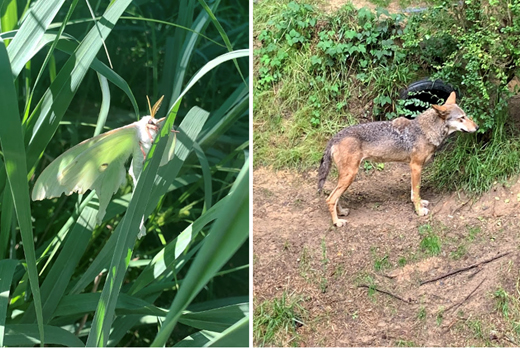Lauren Rooney: Lemurs and Wolves and Bears, Oh My!
“Look! I found a baby turtle!” exclaimed a kid who was no more than 5 as I walked by the Earth Moves exhibit’s sand pit and stream. I looked down at his clutched hands and there it was- a yellow-bellied slider no more than the size of a quarter. That day I rescued the turtle he had shown me and three of its siblings that had wandered into the crowded exhibit by relocating them to the far side of the pond in which they reside. As I picked each one up, I got to show a few curious museum patrons the turtles up close. Their excitement and curiosity were incredible. This was one of my first experiences working at the wonderous Museum of Life and Science, where humans and nature interact side-by-side.
Over the summer of 2021, I got to work as a Ranger for the Museum of Life and Science. Located just outside of downtown Durham, NC, the Museum is an 84-acre interactive science park with over 60 species of animals and 24 exhibit sections related to math, science, nature, and wildlife. There you can see an aerospace exhibit with a prototype of the Apollo 15 Lunar Lander borrowed from NASA, a weather and environment educational exhibit, a butterfly house with tropical rainforest plant species, an insectarium, rehabilitated species of Carolina wildlife, life-sized dinosaur replications, black bears, lemurs, tortoises, red wolves, beautiful wetlands, two acres of woods with a stream and treehouses, a farmyard, and more. It truly is a place where you can learn, explore, and invigorate your passion for our world at any age.
As a Ranger, I worked in all sorts of weather conditions to ensure the safety, satisfaction, and learning experiences of Museum guests. I aided in enforcing policies related to the COVID-19 pandemic, responded to emergencies such as reuniting lost families or taking the proper steps when someone was injured, walked the grounds to make sure exhibits weren’t broken or out of place, and educated people further on exhibits or species in order to help facilitate an excellent experience for the Museum patrons. For example, people were delighted to learn that a group of lemurs is called a conspiracy or to be shown tree frogs residing in the frog poles that keep them sheltered during the day. I helped provide a more positive and informative experience as guests enjoyed the museum while also looking for ways we could improve. In one instance after responding to bee stings in our water exhibits, I realized that we needed some kind of drinking water available for the bees that reside in our Wander Away exhibit that is full of flowers and pollinators and introduced the idea to the exhibits team.
I was also able to spend a lot of time in nature learning, exploring, and watching things grow and change. I witnessed two geese that had goslings grow into fully fledged adults that had to be shooed from sitting in the middle of the path. I watched flowers bloom and wither, eggs be laid in nests and hatch, and the museum change day to day. I learned a lot about species habits and identification from the other Rangers and my own research. Not only did I get to see the rare Luna Moth, spend time with a bumblebee that could no longer fly, and find frogs turtles and birds, but also showed delighted guests as well. I was taught by the other Rangers about the invasive red swamp crayfish that had taken over our wetlands within the last few years, reducing species diversity and water quality, and their efforts to trap and remove them. My personal favorite was getting to educate patrons about the endangered red wolves. It was extremely fulfilling to talk to people about how the brothers that they were looking at, Eno and Ellerbe, are part of the Red Wolf Species Survival Plan and how few of them are left in the wild in Eastern North Carolina. Many people had passed right by the Alligator River without even knowing it was home to the world’s most endangered wolves, and they took home with them a new sense of importance and respect in regard to their preservation.

This experience has helped me discover my passion for conservation, especially of endangered species, as I learned more about red wolves and passed on my knowledge to guests. It has also taught me about the delicate balance of ecosystems, specifically in the context of invasive species, which has ignited my interest in restoration as well. I will continue to work on my Environmental Science degree at NC State University with possible concentrations in applied ecology and wildlife sciences. This will allow me to potentially aid in organizations such as the Red Wolf Species Survival Plan to help save critically endangered species from extinction in the future, as experts at the Museum of Life and Science do. My experience has also shown me the importance and impact of environmental education and opened me up to the possibility of pursuing it professionally that I had not before considered. My position as a Ranger has also helped foster my love for the outdoors and nature, as every day I was able to immerse myself in it. The work I did solidified my enjoyment of being hands-on and learning, something that will be taken into account when I look to my future career. I learned so much about different species from the other Rangers that I will take with me throughout my career and my life, as their passion and knowledge further inspired me. My summer was an incredible and life-changing one, and I am extremely grateful for the opportunity I was given.
- Categories: